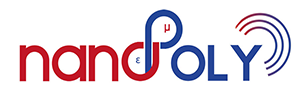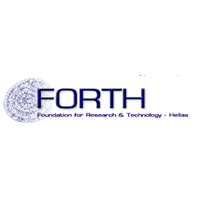Contact
George DELIGEORGIS
deligeo@physics.uoc.gr
FORTH participates in the project with the Microelectronics Research Group (MRG) of its Institute of Electronic Structure and Laser (IESL).
The Institute of Electronic Structure and Laser (IESL) of FORTH at Heraklion, Crete, is an internationally recognized center of excellence in Lasers and Applications, Microelectronics and Devices, Polymer Science and Theoretical and Computational Physics. Its aim is to sustain and advance basic and applied research in carefully selected areas, and also to promote and advance technology in Greece.
The Microelectronics Research Group (MRG) of its Institute of Electronic Structure and Laser (IESL). MRG was founded in 1986 and since then it has evolved into a unique, in Greece, full-scale research facility in compound semiconductor micro/nano-optoelectronics working on III-arsenides, III-nitrides, SiC, carbon electronics, oxides and tellurides . Over the years it has participated into many international projects (FP, ENIAC, NATO) like ESPRIT (Nos. 1270, 2035, 2289, 3086, 5018, 5031, 9500, 21315, 28998), RACE (No. 1027), BRITE/EURAM 5416, NATO Sfp “HP-HF SiC power devices”, NATO Sfp “SICPIN”, a US Army ERO on SiC power devices, “QN laser I”, “QN laser II”, “GaNANO”, “AMICOM”, “ULTRAGAN”, “BONTEC”, “PICMOS”, “MORGAN”, “TARGET”, “NANOTEC”, “SMARTPOWER”, “NANORF”, “MERCURE”, “NANOCOM”, “ARTEMOS”, “CLERMONT”, “ICARUS”, “INDEX”, POLAFLOW” “VISOSURF” and numerous national projects. To exploit its accumulated expertise, the group has launched a microelectronics services activity providing epitaxial wafers, processing and measurement services. The latter two are ISO 9001 certified. In 2005 FORTH was among the winners of the Descartes prize for its work on left handed materials. MRG disseminates its research in high quality journals including Science and Nature. MRG has been working with 1D and 2D material nano – fabrication since 2008 and with conventional semiconductors MMIC since its inauguration in 1986. Among the many technical skills developed is a complete MMIC fabrication platform and component library for GaAs (up to 77GHz) and GaN (up to 15 GHz) integrated microwave circuits. Recently (2015) a component library was created for processing of 2D (graphene) and CNT based electronics. In parallel SiC nanowire high voltage JFETs (2017) have been developed. The 2D / 1D activity has recently been enhanced by a new laboratory including CVD for growth of Carbon (CNT and graphene) and 2D sulfide based materials.
Resources:
Clean Rooms: Approximately 200 m2 of class-1000 for MBE and device fabrication. Material Growth: New MBE system (RIBER 32P) for nitrides with NH3 injector and N2 RF plasma sources, set-up for excimer Laser Assisted MBE (LAMBE) and MBE system with two coupled growth chambers (VG 80H/80S) for III-V and SiC-Si. Device Fabrication: wet chemistry sinks, photoresist spinners, UV and deep-UV mask aligners with backside alignment capability, FESEM Jeol 7000 with Raith nanolithography system, e-beam evaporator, RF and DC sputtering, thermal evaporators, rapid thermal annealing, sintering, bonding and wafer thinning and dicing, RIE and PECVD systems. Material Characterization: AFM, SEM and optical-Nomarski microscopes, contactless sheet resistance probe, electrochemical C-V profiling, Hall effect at 300 K and 77 K, DLTS, 14-300 K photoluminescence (PL), micro photoluminescence (μPL), electroluminescence (EL), modulated optical spectroscopies (PR, ER, PT), photocurrent (PC) and photovoltage (PV). Access to the UV Laser Facility (LSF) of IESL. Device testing: C-V, quasistatic I-V, EL spectra and efficiency, RF S-parameter, noise and power measurements up to 20 GHz, on-wafer RF probes.
Role in Nanopoly:
FORTH will lead WP3 (Downscaled component fabrication and characterization)
- Study metamaterial miniaturization and Design the metamaterials to be used in the project (FORTHPPM)
- Fabricate and do initial characterization of metamaterial properties (FORTH-PPM)
- Fabricate all devices, components (FORTH-MRG)
- Fabricate circuits and modules (FORTH-MRG)
Key personnel:
Dr. George Deligeorgis (male) earned his PhD in 2008 working on GaAs based Semiconductor laser diodes for telecommunication applications. Following his PhD, carbon-based devices (Graphene and CNTs) became his principal research interest. He stayed in LAAS-CNRS (Laboratory for analysis and architecture of Systems, National Center of Scientific Research), in France between 2010-2014 where he continued his activity in the same subject. He has recently (2015) accepted an Associate Researcher position in FORTH – IESL, Greece to work on high frequency graphene devices for radar applications. Dr. Deligeorgis has worked on numerous projects in design and fabrication of compound semiconductor devices in the field of photonics and high frequency electronics (MMIC) for the last decade. He was involved in several National and European funded projects in the fields of photonics, RF device fabrication and polaritonic devices. He is currently heading the graphene and nanofabrication activity in his group, working on nonlinear graphene based RF devices and polariton optoelectronics devices combining his knowledge in physics and nanotechnology. He has published more than 60 articles in peer-reviewed journals and has several invited and contributed talks. Finally, Dr. Deligeorgis is a founding member of the “Graphene Center, Greece”, member of the Steering board of Micro & Nano nanotechnology company, a member of several associations (IEEE e.t.c) and a reviewer in several international journals. Dr. Deligeorgis has more than 1300 citation and an h-index of 19.
Prof. Maria Kafesaki (female) is an Associate Professor in the Dept. of Materials Science and Technology of the University of Crete and associated Researcher at the Institute of Electronic Structure and Laser (IESL) of Foundation for Research and Technology Hellas (FORTH). She obtained her Ph.D. in 1997, at the Physics Department of the University of Crete, Greece. She has worked as post-doctoral researcher in the Consejo Superior de Investigaciones Scientificas in Madrid, Spain, and in IESL of FORTH. Her research is on the area of electromagnetic wave propagation in periodic and random media, with emphasis on photonic crystals and metamaterials, especially negative refractive index materials. She has around 90 publications in refereed journals and conference proceedings with ~4500 citations and h-index 35.

